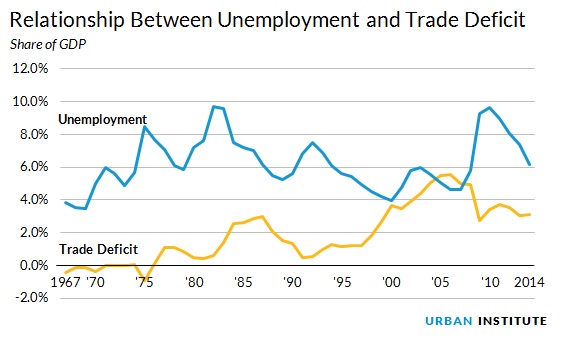Does Trade Cause Job Losses?
Most Democrats in the House of Representatives opposed granting the president Trade Promotion Authority because they think international trade has been bad for American workers. (The legislation, which President Obama signed yesterday, gives the president guidelines for negotiating trade agreements and promises that such agreements will be given an up-or-down vote in Congress, with no filibustering or amendments.) Part of their opposition is based on the prevalence of the "Made in X" label, where X is often China or another low-wage country. The mass media perpetuates this concern by creating "challenges" to buy only American-made products for Christmas or for furnishing a house, saying that it is doable but very difficult.
But this is a myopic way of looking at international trade. Consumers, who typically interact only with retailers, never see many elements of the economy. Behind each final sale is a long chain of activities embedded in the cost of the good or service.
Consider the process of making shoes. Only 50 percent of the final price goes toward imports, paying for materials, manufacturing, and packaging. The American half of the cost of shoes pays for shipping, retail mark-up, advertising, insurance, and the cost of renting space. LeBron James's Nike endorsement and even the camera operators who film Nike ads are part of this process.
Shoes are America's single most import-intensive product. About 45 percent of the final price of clothing and new cars goes abroad. And all those stories about a lack of American-made toys or furniture miss the fact that the American component of the final price of these items is 73 and 78 percent respectively.
Many toy and furniture workers lost their jobs because of the great jump in imported products in these areas. And many of the communities in which these workers are concentrated were hard-hit. But the 16.5 percent of GDP that imports represent is mostly offset by the 13.5 percent of GDP that comes from exports.
The common-sense view is that this 3 percent trade deficit leads to an equivalent share of the labor force not having jobs that they otherwise would have. Most economists, however, think the trade effect is minor. In particular, as the accompanying figure shows, they look at the unemployment rate and the deficit as a share of GDP and don't see any correlation. For example, in both the 1980s and the 1990s, the trade deficit was rising and the unemployment rate was falling.
The problem with the trade debate is that both sides overstate the effects of trade. The opponents of trade point to the many products assembled abroad as evidence that a substantial portion of the workforce is at risk of being outsourced. The proponents cite the large number of export jobs to argue that trade is a net job gainer for Americans. In reality, the biggest benefit of trade is that it makes the world economy more efficient, which leads to lower prices in highly industrialized countries like the United States. By one estimate from a group of Harvard researchers, the benefit of trade could be as high as $1 trillion a year.

The benefits of trade are substantial but diffuse, while the costs to displaced workers and their communities are smaller but far more concentrated. Theoretically, this can be solved by having those who benefit from trade subsidize those who lose. While this is the logic of the recent trade bill, subsidies of the size the legislation offers have historically not been enough to re-train these workers so that they can get comparable jobs.
Hence, those who may face displacement oppose expanding trade, and the labor and progressive movements in this country have successfully pressured congressional Democrats — and presidential candidate Hillary Clinton — to oppose the trade act, even though the number of workers who will be affected is relatively small.
Stephen Rose is an affiliated scholar with the Urban Institute and research professor with George Washington University.




